African swine fever (ASF) is a re-emerging infectious disease that affects only swine species and is a reportable disease to the OIE that affects trade.
Because there is no effective vaccine available against ASFv, quarantine measures and stamping out are the only alternatives for farms that are diagnosed positive to ASFv. In the unfortunate event of ASFv introduction into a farm, early detection and elimination of the infectious source is imperative to avoid further spread of the virus to other farms.

Will we be able to detect the virus before it is too late to avoid spread to other farms?
ASF clinical case
In my personal experience with ASF in Russia, the disease presented itself in a subclinical form, with a slow disease progression and transmission. The affected farm was a finisher site with 16 rooms and a total of 30,000 pigs on site. There was a slow rise in mortality in 1 specific room of the farm. The affected pigs started showing loss of appetite, fever and bloody diarrhea. The mortality increase was slow but consistent until it reached 7% of total losses in a period of 10 days after initial observation of disease. The affected pigs did not respond to treatment of injectable antibiotics and the severity of clinical signs increased enough to raise concern by the farm staff. ASFv was later confirmed by laboratory testing.
During this 10 day period there was a movement of asymptomatic gilts from a room without clinical signs to an off-site gilt developer unit (GDU). These gilts had tested negative to ASFv by PCR prior to shipment and there were no clinical signs in the room. After arrival to the GDU the gilts started showing similar clinical signs as reported in the finisher site but with faster disease progression, reaching 10% losses in just 3 days. The GDU tested positive for ASFv 3 days after the arrival of the gilts from the infected finisher.
All animals in the infected finisher were euthanized in a period of 5 weeks after ASF detection. 12 of the 16 rooms remained negative to ASF those 5 weeks and the highest mortality observed in the infected rooms was 15%.
My experience with ASFv is similar to other reports that ASFv can cause mild clinical signs, with low mortality rates in the early stages of the disease. However, there is wide variability on the severity of the clinical signs reported from the affected countries. There are reports from countries in south East Asia where the disease is presenting itself in the acute form with high mortalities that reach 90% in short period of time.
ASF disease presentations
Depending on the virulence of the strain and the route of exposure, the incubation period will vary from 4 to 19 days and the disease may have four different presentations:
- Peracute: High mortality that can reach up to 100% within the first week post infection. This disease presentation occurs with highly virulent strains and sudden death is the common finding. The disease progresses quickly and most pigs will not show evidence of clinical signs before they die.
- Acute: This disease presentation is the one that veterinarians often expect to see in the face of an ASFv outbreak. High mortalities that may also reach up to 100% but the disease progresses slower than the peracute presentation, it may take up to 3 weeks for the mortality to reach 100%. The observed clinical signs are evident and severe. More specifically, we can expect fever, hemorrhagic skin lesions across the pig’s body, respiratory distress with hemorrhagic nasal discharges before the animal dies. At necropsy we can expect to see hemorrhagic lesions in multiple organs, commonly reported are the kidney, lymph nodes and enlarged spleen, although we should not expect to find these lesions in all the infected pigs.
- Subacute: The clinical signs are similar to those seen in the acute form but less severe. The mortality may reach between 30-70% within the first 3-4 weeks post infection. The disease progression will be significantly slower than the acute presentation and the clinical signs may not be as evident as expected.
- Chronic: Clinical signs are diverse, loss of appetite, weight loss, bloody diarrhea, respiratory distress and arthritis have been reported. Mortalities stay below 20%, most animals survive and become shedders of the virus for months.
Early detection of ASF
Early detection of the disease can be a challenge due to the lack of specific clinical signs for ASF. The severity and variety of the clinical sigs will vary depending on the virulence of the ASF strain and whether other infectious agents are present.
The differential diagnosis is complicated because the clinical signs and macroscopic lesions may resemble those seen with other swine diseases like erysipelas, salmonella, classical swine fever, high pathogenic PRRS, porcine dermatitis and nephropathy syndrome and swine dysentery.
The disease may go undetected for several days until the clinical signs and the increase of mortality become high enough that triggers an investigation. Furthermore, existing diseases in the farm may delay the diagnosis of ASF because the early rise of mortality and clinical signs may be attributed to other diseases that are present in the farm. This facilitates further spread of the virus to other farms by movement of infected asymptomatic pigs in the early stages of the outbreak.
The clinical signs observed in cases of ASFv are:
- Fever (>40 degrees)
- Appetite and weight loss
- Hemorrhagic skin lesions. Most commonly found on the ears and distal parts of the limbs.
- Hemorrhagic diarrhea
- Vomiting
- Respiratory distress
- Hemorrhagic nasal discharge
- Abortion in sows
- Sudden death
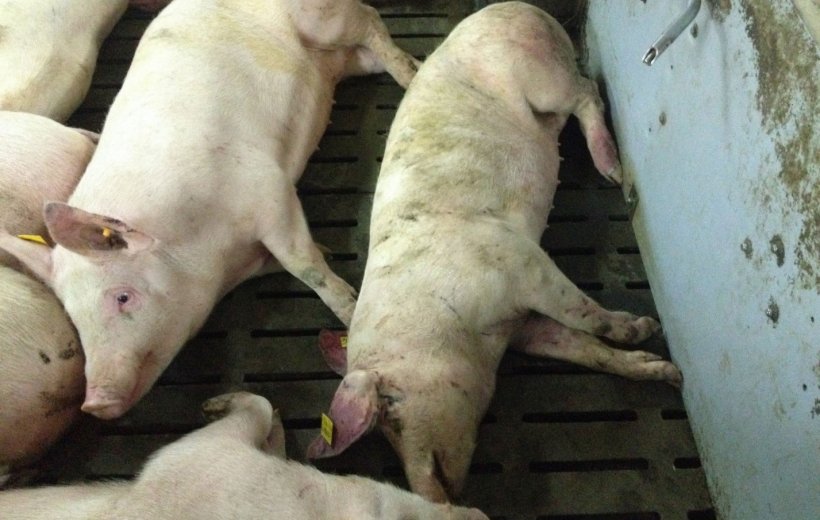
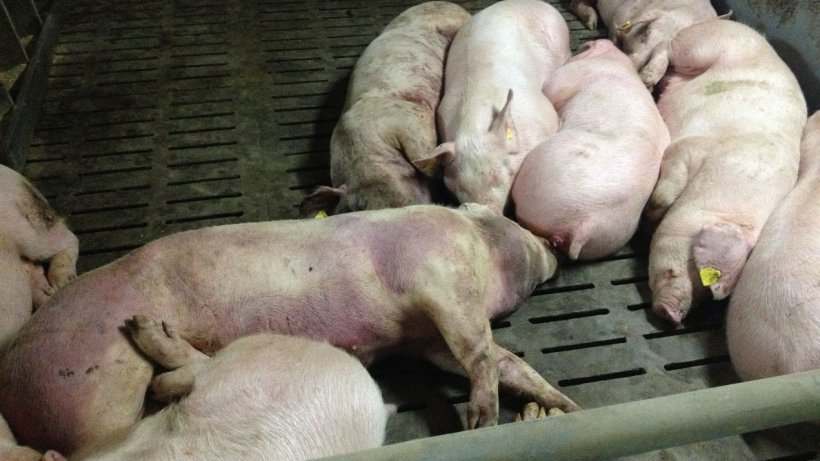
Macroscopic lesions commonly found on ASF cases
- Petechial hemorrhages in multiple organs but most commonly found in the kidney and bladder.
- Splenomegaly (enlarged spleen)
- Hemorrhagic and enlarged lymph nodes.
- Pericarditis with excess of pericardial fluid
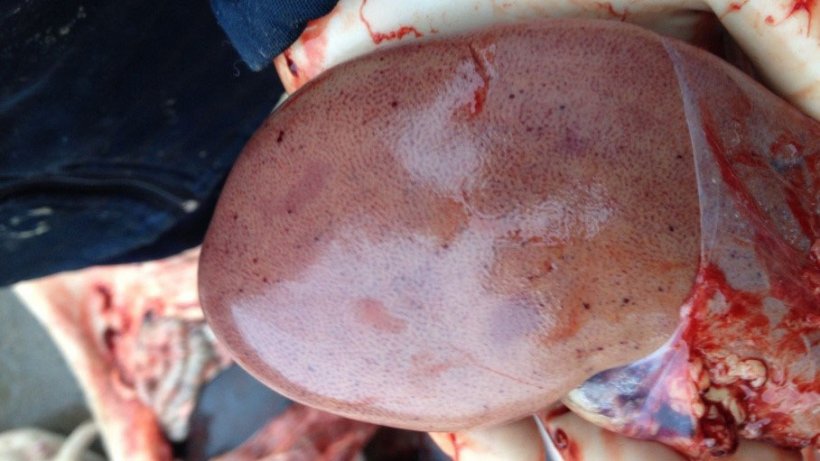
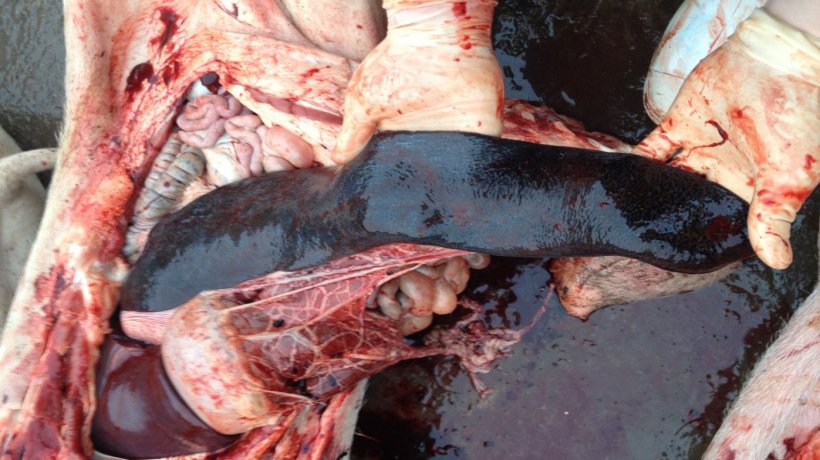
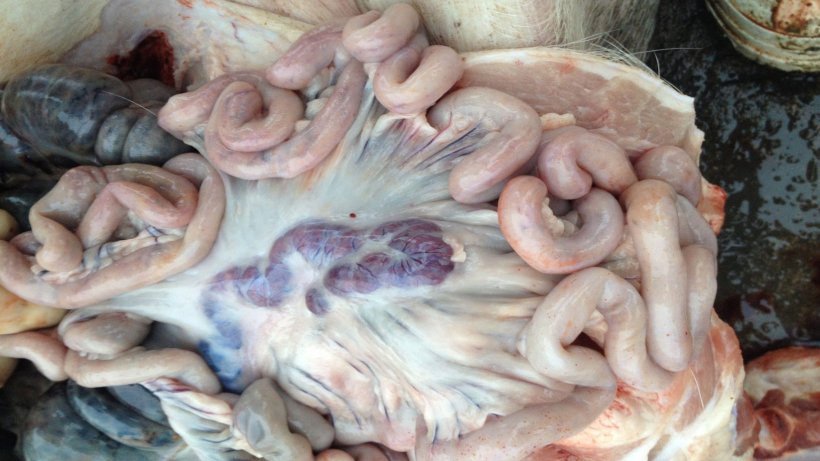

All these are a summary of the most commonly reported clinical signs from multiple outbreaks in different countries. However, not all the clinical signs will be present during the course of an outbreak. In the face of an ASFv outbreak not all the pigs will get infected at the same time, therefore we should expect to see variability in the severity of the clinical signs between animals.
Laboratory diagnostic
Because of this wide variety of clinical signs and lack of lesions specific to ASFv, it is imperative to rely on laboratory testing for diagnosis. There are a multiple validated tests available for viral and antibody detection of ASFv. PCR is the commonly used test for detection of the virus in the early stages of the disease. Whole blood, spleen, kidney and lymph nodes are the preferred sample type for viral detection. Intermittent shedding has been reported in the chronic form of the disease, therefore it is important to perform serological testing for detection of antibodies in addition to the PCR.
In countries where laboratory facilities are lacking or are limited, diagnosing African Swine Fever on the early stage of the disease can be a challenge. This further complicates the diagnosis and early detection of the disease.
Key points
- Clinical signs will vary depending on the virulence of the strain
- Clinical signs may resemble those observed with other important swine diseases
- Mortality may be low in the first 2 weeks of disease progression
- Infected pigs can be asymptomatic carriers of African swine fever virus
- Reliable and fast diagnostic testing are key for early detection







